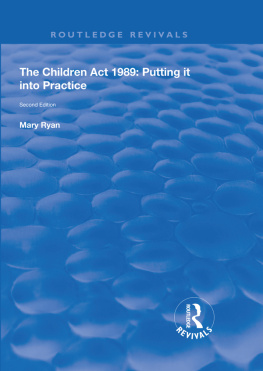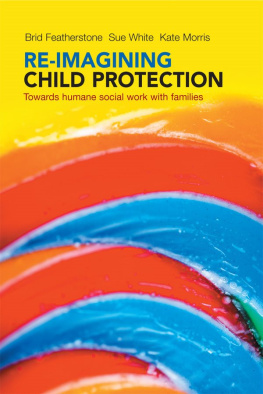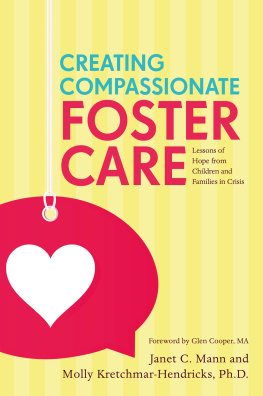The Children Act 1989: Putting It Into Practice
To Archie and my children
Daniel, Max and Euan
Dartington Social Research Series
Titles in the Series:
Making Residential Care Work
Structure and Culture in Childrens Homes
Elizabeth Brown, Roger Bullock, Caroline Hobson and Michael Little
Secure Treatment Outcomes
The Care Careers of Very Difficult Adolescents
Roger Bullock, Michael Little and Spencer Millham
Research in Practice
Experiments in Development and Information Design
Roger Bullock, Daniel Gooch, Michael Little and Kevin Mount
Children Going Home
The Re-unification of Families
Roger Bullock, Daniel Gooch and Michael Little
The Children Act 1989: Putting it into Practice
Second Edition
Mary Ryan
First published 1999 by Ashgate Publishing
Reissued 2018 by Routledge
2 Park Square, Milton Park, Abingdon, Oxon 0X14 4RN
711 Third Avenue, New York, NY 10017, USA
Routledge is an imprint of the Taylor & Francis Group, an informa business
Copyright Mary Ryan 1999
All rights reserved. No part of this book may be reprinted or reproduced or utilised in any form or by any electronic, mechanical, or other means, now known or hereafter invented, including photocopying and recording, or in any information storage or retrieval system, without permission in writing from the publishers.
Notice:
Product or corporate names may be trademarks or registered trademarks, and are used only for identification and explanation without intent to infringe.
Publishers Note
The publisher has gone to great lengths to ensure the quality of this reprint but points out that some imperfections in the original copies may be apparent.
Disclaimer
The publisher has made every effort to trace copyright holders and welcomes correspondence from those they have been unable to contact.
A Library of Congress record exists under LC control number: 99204958
ISBN 13: 978-1-138-34121-0 (hbk)
ISBN 13: 978-0-429-44026-7 (ebk)
Much of the practical information in this book arises from my involvement in the advice, training and policy work of the Family Rights Group from 1982 until 1996. I would like to thank all my former colleagues from FRG, particularly Jo Tunnard and Celia Atherton.
I would also like to thank my current colleagues at the Dartington Social Research Unit for their comments and suggestions for the second edition.
In this book when the term care is used in relation to pre-1989 legislation it refers to children in both compulsory and voluntary care, which would now be care or accommodation.
References to section numbers or paragraphs from schedules are from the Children Act 1989. References to schedules combined with a section or paragraph number, or standing alone, are to schedules of the Children Act 1989. References to schedules following a Regulation are to the schedules of those particular Regulations. Where a reference is made to other legislation the relevant Act is included in the reference. Initials are used as follows:
FLRA 1987 Family Law Reform Act 1987
CYPA 1969 Children and Young Persons Act 1969
PACE 1984 Police and Criminal Evidence Act 1984
FLA 1996 Family Law Act 1996
There are two relevant sets of court rules:
the Family Proceedings Court (Children Act) Rules 1991, referred to as FPC 1991, which apply to the family proceedings courts,
the Family Proceedings Rules 1991, which apply in the county court care centres and the High Court, referred to as FP 1991.
The rule numbers are mainly the same and we have used the FPC 1991 rules throughout, except where there is a difference between them, which is indicated in the text.
This book concentrates on those parts of the Children Act 1989 that relate to the provision of services by local authorities to children and families; the powers and duties of local authorities in such circumstances; care and supervision proceedings, and child protection issues. There is some consideration of the private law in so far as it relates to child care matters, and to the court system and the principles which govern it.
The book is intended for use by key frontline workers and managers involved in child care work, especially social workers, guardians ad litem, education welfare officers, teachers, probation officers, senior nursing officers, doctors, health visitors, and police officers working in juvenile bureaux or special assessment teams. It is also relevant for child care solicitors based in a local authority or private practice.
This second edition contains information from research into the implementation of the Act, up-to-date case law, relevant new legislation and guidance from the courts, and government and specially commissioned reports on various aspects of the child care system. Research studies have looked both at social work practice and at practice within the courts and contain many important findings that both legal and social work practitioners should be aware of.
In 1984 the House of Commons Social Services Committee produced a report on children in care. The report (known as the Short Report) did not doubt the good intentions of workers and agencies but it was critical of the lack of resources and skills made available to promote the well-being of children in the community and in care. The committee considered child care law to be in urgent need of reform. It stated that the aim of the review of child care law that they proposed should be
the production of a simplified and coherent body of law comprehensible not only to those operating it but also to those affected by its operation. It is not just to make life easier for practitioners that the law must be sorted out; it is for the sake of justice that the legal framework of the child care system must be rationalised. (House of Commons 1984)
The Government responded by setting up an inter-departmental working party which, between July 1984 and September 1985, carried out a detailed consultation exercise on all aspects of child care law. Their report made 223 recommendations for improving, clarifying and consolidating both child care law and health and welfare legislation relating to children DHSS 1985(1)).
This was followed in January 1987 by the publication of a White Paper which set out proposals for a new legislative framework largely based on the recommendations of the review DHSS 1987(1)).
At the same time, between 1985 and 1988, the Law Commission was issuing consultation papers on the law relating to children involved in custody, guardianship and wardship proceedings. Their final report (Law Commission 1988), issued shortly after the Cleveland Inquiry Report (DHSS 1987(2)), contained a draft bill which formed the basis of the Children Bill introduced into Parliament in November 1988.
There were other important influences on the Act. First, there were research studies into the circumstances of children in care. Nine separate studies looking at the child care service in 49 local authorities and covering some 2,000 children had been produced, and their findings brought together and published by the DHSS in 1985. These studies painted a sober picture of current practice, and concluded that the gap between aims and achievements in the child care service is still distressingly wide DHSS 1985(2), p.22).





